
Plastic surgery and the quest for the perfect selfie in South Korea
Plastic surgery has changed the world. One aspect of globalization is the normalization of homogeneous, “westernized” beauty and the speed of its spread through various media over large parts of the world. The development and the easy access every individual has to social networks have only made this process more common. Everyone can take a selfie, post it online and then wait for feedback in forms of likes and comments. But is this process really as easy as it seems?
In this article, we are going to deal with the measures taken to make an ordinary picture of your Instagram account “on point” and what some are willing to do in order to score those 10,000+ likes.
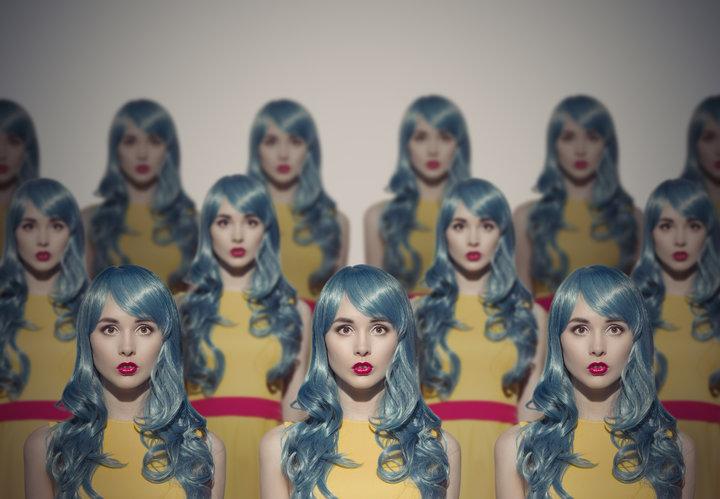
Ever noticed micro celebrities looking quite alike?
Plastic Surgery: beauty or abnormality
What does it take to become “insta famous”? In order to attract more followers, to show “...what many young people dream of having and the lifestyle they dream of living” (Marwick, 2005), you need to be nice to look at. “...Sexual properties are as inseparable from class properties as the yellowness of a lemon is from its acidity.” (Bourdieu, 1984) But how do you differentiate yourself as good-looking?
At this point, girls mostly start looking at famous profiles, magazine covers and the celebrities that get the most hype. They soon discover that there are certain “rules” to being beautiful. They might differ, but in most countries it is essential to have long hair, big eyes, plumped lips, a thin waist, and all the other necessary “standard” attributes to attract others’ attention.
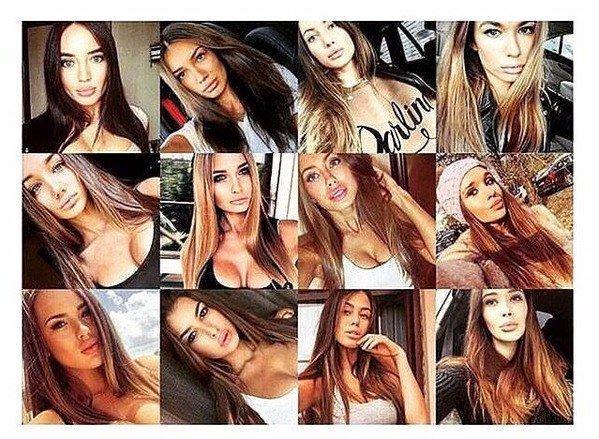
Selfies of different girls on social media
“Micro- celebrity, a self- presentation technique, in which people view themselves as a public persona to be consumed by others, use strategic intimacy to appeal to followers, and regard their audience as fans" (Marwick & boyd, 2011). One might notice, looking at famous personalities and micro-celebrities, that many of them have a similar kind of look. Their appearance is thus being “normalized” in terms of beauty. They are pretty in a “standard” way with “typical”, ideologized feminine features.
“The gendered femininity constitutes one of the most important aspects of female erotica,... and is a great value to its beholders” (Li, 2018). Being good-looking is thus quite profitable for young females in social, economical and cultural ways. Great value is also added by social media, where these girls are constantly being judged, or approved by their followers.
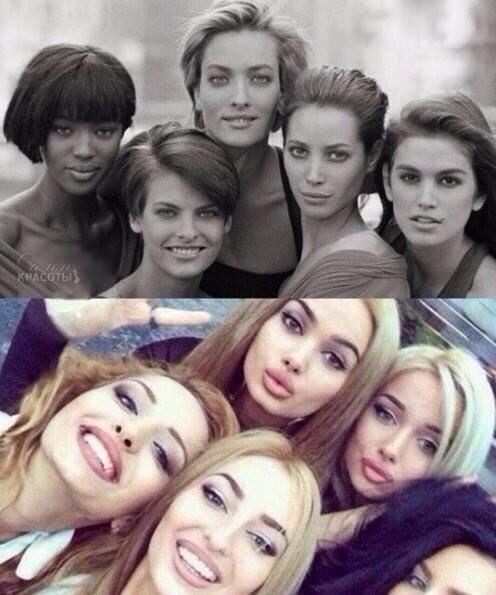
The shift of beauty standarts
Wanna-be (micro-)celebrities, however, might end up feeling “abnormal” with their thin lips, different body types, short lashes, etc. This doesn’t mean that they don’t have any chance of getting their dose of hype though. Plastic surgery and different body manipulations might become a shortcut to becoming “normal” in terms of Instagrammed beauty standards. “Women’s investments in physical attractiveness are often pathologized and perceived as in need of being rectified.” (Li, 2018)
At this point, “paraphrasing Foucault (1986), we shall use “the care of the selfie”: an elaborate complex of “ludic” practices aimed at constructing and performing a specifically online (and more specifically small-screen) “image of personality” in which usually three different elements have to be carefully created and maintained:
- an avatar: an online name often containing significant clues as to the particular image of personality offered in interaction;
- carefully doctored pictures or video-streamed images of the selfie;
- specific online interactional scripts to be observed in contacts with audiences.” (Blommaert & Li, 2017)
The popularity of certain procedures for changing one’s appearance keeps growing year by year. “The care of the selfie” has reached ridiculously massive scales. Right now, we are facing an unbelievable spread of plastic surgery in different parts of the world. Some countries even become the “mekkas” for body modification pilgrimage. One of such places is South Korea. How did the selfies influence young social media users into tuning their bodies and turn the country into one of the world’s plastic surgery capitals?
Beauty standards in South Korea
As Li (2018) puts it, in relation to Hamermesh (2011): “... [beauty] spells out a wide range of economic advantages conferable by good looks, mainly in labor markets and employment, marriage,... friendship matches” and in profitable use of social media. Young South Korean girls thus have a whole industry developed for them, in order to get closer to the ideal look.
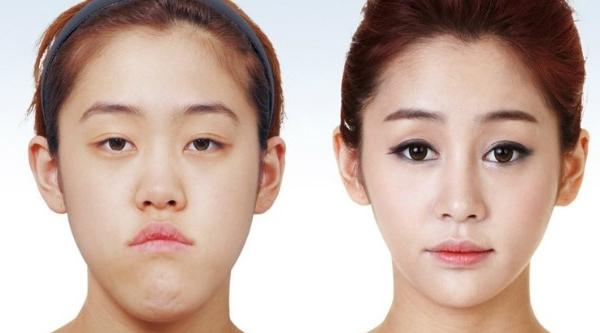
Before and after: plastic surgery in South Korea
“The choice and the visual architecture of the pictures is deliberate.” (Li, 2018) Jawline, rhinoplasty, cheekbone reproduction - the list of the essential “selfie-helpers” can go on and on and is nearly endless. Multiple filters and apps for picture retouching only have a purpose in the final stages, to come as close to perfection as posible. Behind every ideal, likeable selfie is an entire system.
In the case of South Korea, “the care of the self”, as Foucault would call it, has gone too far. In a world in which social media have become a part of our lives and where people want to become popular in the “attention” economy that social media have created through their Liking and Favoriting functions. South Koreans need to undergo severe body modifications to reach the highest results and to conform to the beauty standards of their society. The fight to look and be normal is hard for those considered "abnormal" by South Korean norms.
Far-fetched beauty standards in Asia are far from new. In China, foot binding was considered a mark of beauty and a status symbol, and surprisingly, this practice lasted for centuries. Extreme South Korean standards of beauty got out of hand during the 21st century, because of the following factors: the massive spread and importance of social media and the rise of Korean Pop Music (K-Pop), which has become one of the biggest and toughest musical industries in the world.
The most recent trend with regards to plastic surgery in South Korea, is having a more “Westernized” look. This can be traced back to the influence of Hollwood and the fashion industry, where “western-looking” girls are still the primary actors. Both Hollywood and the fashion industry are highly mediatized. The pressure to look good is definitely higher in a mediatized society and it aplies to both female and male South Koreans, especially if they want to become public personas or K-pop musicians.
Another fascinating aspect is that in Asia, a lot of camera apps have been created that feature real time modifications and unusual filters that wash away pimples. No other camera app can beat the unusual functions that Chinese or South Korean apps have in store for you. One of these extraordinary camera apps is called Cymera, which allows you to enhance your selfies to the maximum. It has beautifying functions that go as far as contouring your jaw line to obtain an exaggeratedly chiselled jaw or to enlarge your eyes in order to achieve the anime girl look.
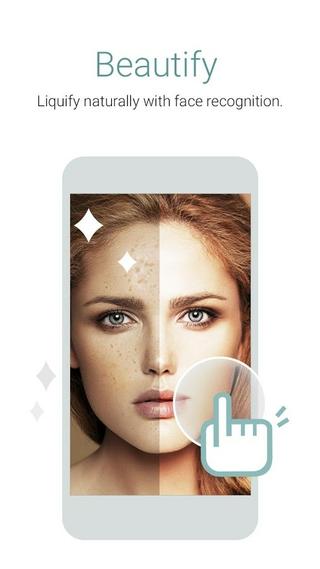
Beautify through a camera app
Plastic surgeries in Seoul
In fact, the problem with extreme beauty standards got so widespread in Seoul that locals started protesting against the popularization of unnatural beauty standards and the spread of plastic surgery commercials. The aim of such ads is to spread the message that you could look as good as the people in them; all you need to do is go through the procedure.
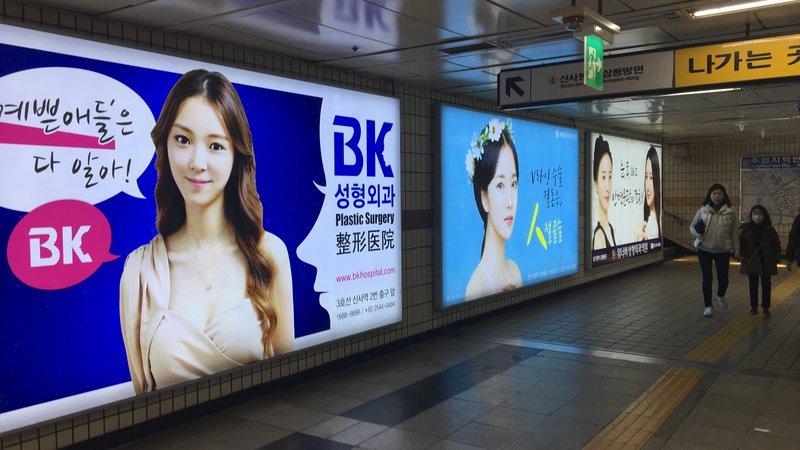
Every ad in Seoul metro is about using plastic surgery
Commercials thus apply to our instincts, which has the effect that we feel the need to alter ourselves. Ads like these make us feel as though our bodies are wrong, tricking society into believing that the only way to become who we really are, is by undergoing plastic surgery.“Identities and senses of ‘being oneself’ are based on and grounded in miniscule deviations from standard formats and scripts that organize most of what this ‘being oneself’ is actually about.” (Blommaert & Varis, 2015)
Plastic surgeries take place, but are mostly undergone to fit in better with society. Under such constant pressure from social media and commercials, many young South Korean girls use plastic surgery to remove any features of theirs that might be seen as 'abnormal', in order to pursue a career as a micro-celebrity: "Constructing identity in dialogue with the Facebook protocols & algorithms makes us ‘micro-celebrities’ in managing our identity in interaction with protocols & algorithms for an imagined audience." (Maly, 2017)
According to Gallup Korea, one out of three women between the ages 19 and 29 have undergone plastic surgerye. The number is shockingly large, compared to other countries’ statistics. Numbers like this make South Korea the country with the most used beauty modification industry in the world.
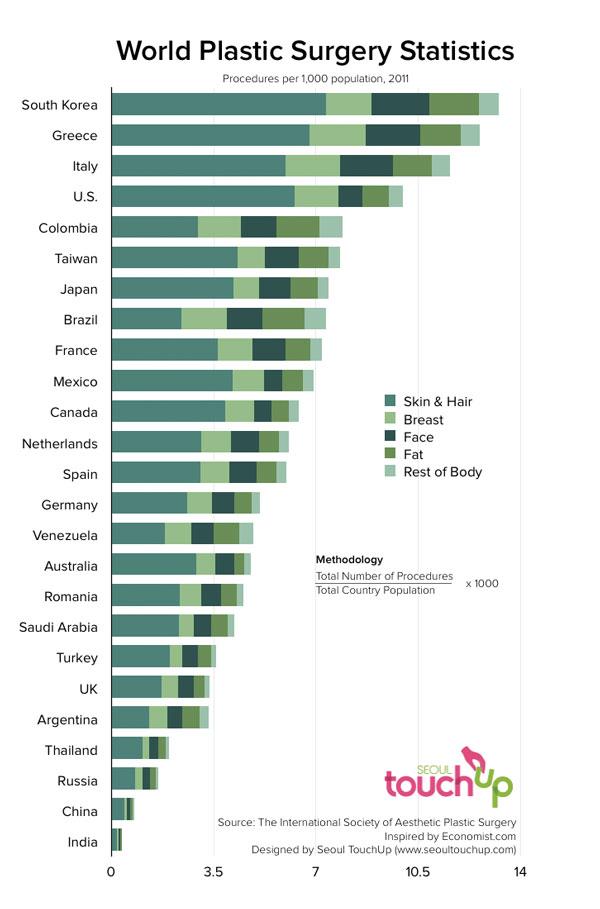
World plastic surgery statistics
However, the plastic surgery niche in South Korea is not only a matter of culture, but also an industry worth billions of US dollars. This is why the examples, like the one with the metro station above, are not exceptions, but signs of how the phenomenon has spread all over the country. Moreover, the industry not only involves the local population, but has also led to so-called “plastic surgery tourism”.
Agencies that promise to arrange “the best medical experience for you” attract thousands of those who are unsatisfied with their looks. They are easy to find, too - hundreds of “plastic surgery travel package” offers pop up on Google whenever you search the topic. This also has an influence on the tourism branch within the country. The high demand for plastic surgeries leads the openings of new medical centers and rehabilitation clinics. The active monetization of the niche attracts more young people to get a degree in the field of plastic surgery and more universities and private colleges aim to open sufficient positions. In other words, the industry is profitable and this is one of the main reasons it is spreading all around the country.
A society in which stigmas are “deleted”
Due to the increasing amount of plastic surgeries that are performed in South Korea, beauty standards are evolving accordingly. When almost everyone undergoes plastic surgery, the urge to look good can be felt by those who still haven’t had any procedures done.
The ideal Korean woman should be thin, as pale as possible, have big eyes, double eyelids and a very delicate jaw. A lot of South Korean women are not born with these features, and therefore have to undergo jawline correction surgeries in order to achieve the delicate look for themselves. This can be seen most prominently in the K-Pop industry, where most of the musicians have had plastic surgeries. To highlight the mass mania of jawline correction, a plastic surgery clinic in Seoul used to have a tower of patients’ jaw bone shavings.
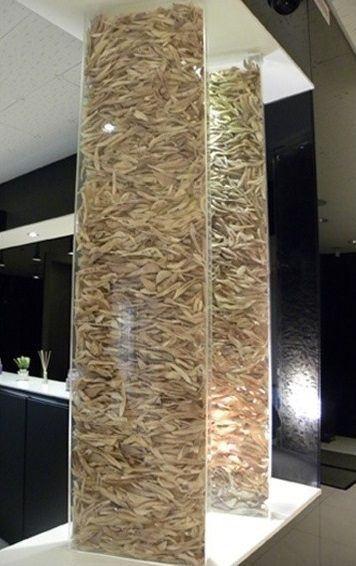
Jawbone Tower
Having a big jaw, being chubby and not insanely white are now stigmatized in South Korean society. According to the sociologist Erving Goffman, a stigmatized person is a person who is considered abnormal by society because of their physical traits, handicaps or group identity markers such as skin colour. Not conforming to beauty standards therefore means being considered abnormal, ugly and not attractive in this society. South Korean women who do not undergo plastic surgery and who want to stay natural become stigmatized; not worthy of attention. This makes starting a career as a micro-celebrity or a K-Pop star impossible for them, unless they conform to the standards.
"For some patients – those who have been discriminated against for looking a certain way, been unhappy with the way they look – plastic surgery could be a powerful tool towards self-determination." (Kyeong Jang, 2018) In Seoul, which is now the capital of cosmetic surgery, plastic surgery is very accessible and more than 1000 plastic surgery clinics are to be found in South Korea. Therefore, getting rid of imperfections and re-entering society after being stigmatized initially can be easily done in South Korea. Plastic surgery has become an empowering tool that gives confidence to those who consider think of themselves as unattractive.
Famous South Korean model shocks her fans about her plastic surgery
Lee Sung Kyung, a South Korean actress and model is the typical Instagram celebrity, being the most famous Korean model on the platform. "Social media is driven by a specific kind of identity construction – self-mediation – and what users post, share and like effectively creates a highly curated and often abridged snapshot of how they want to be seen." (Khamis, 2016).Kyung's successful Instagram account is followed by 8.3 million people. Characteristic for her profile is that she only post "perfect" shots, in which her hair is neat and her makeup is nicely done.
Her looks are beautiful, at least according to South Korean beauty standards. However, to her fans’ shock, she has undergone plastic surgery, but is this really so shocking? This isn’t such a surprising fact if we take into consideration that severe methods have to be taken if you want to be seen as beautiful in South Korea and therefore more and more people choose to undergo plastic surgery. Starting her career as a model and later as an actress implied that she had to conform to beauty norms and to score high in the South Korean beauty industry it is expected that she had surgery.
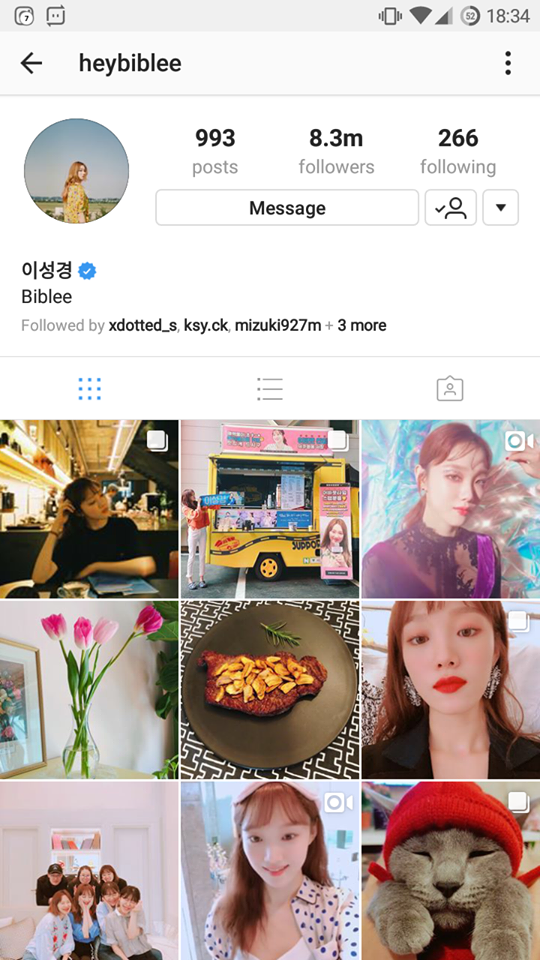
Lee Sung Kyung's Instagram profile
As Li (2018) puts it: "...the newly emerging digital infrastructures have transformed important parts of the fashion industry", thus being active on Instagram as a model can help with gaining popularity and maximizing their profits. Lee Sung Kyung is not known only in South Korea; she is followed on Instagram by thousands of foreigners who love Korean "beauty". Getting the perfect Asian girl look through plastic surgery and then retouching that look even further with camera apps are factors that allow young South Korean girls to gain popularity on social media, where being beautiful is a plus, so that later on they can become models.
Digital media, plastic surgery and normality
We live in a time in which the 'like economy' and the craving for attention are factors that influence young women into doing whatever it takes to become popular and successful on social media. Being beautiful is normal, but not being beautiful is abnormal, and fortunately there are plenty of ways of adjusting yourself in order to conform to society's standards. Ranging from makeup, camera apps, to the extreme plastic surgeries that can even go so far as having a jaw correction done, everyone can get rid of their imperfections and become perfect, opening up the way for themselves to become models.
As we have discussed above, extreme South Korean beauty standards drove one out of three South Korean girls into getting plastic surgery and this is also influenced by their need of gaining popularity online. South Korean girls not only want to be beautiful and be considered normal in their society, but their goal is also to become famous and successful using their erotic capital. Seoul has become the world capital of plastic surgery and we can blame it on both social media and the Korean society's strict beauty standards. The competition that social media involves determines young girls to pull out the last trick from their sleeves - the easy accessibility of plastic surgery In Seoul.
References
Bourdieu, P. (1984). Distinction: A Social Critique of The Judgement of Taste. Cambridge: Harvard University Press.
Blommaert, J., Varis, P. (2015). Enoughness, accent and light communities: Essays on contemporary identities. Tilburg University: Tilburg Papers in Culture Studies.
H., Kyeong Jang. (2018). Why is Plastic Surgery so Popular in South Korea? [Retrieved 10th April]
Li, K (2018). Capitalization of Feminine Beauty on Chinese Social Media. Tilburg: Tilburg University.
Li, K., Blommaert, J. (2017). The care of the selfie: Ludic chronotopes of baifumei in online China. Tilburg University: Tilburg Papers in Culture Studies.
Marwick A., boyd d., (2011). I tweet honestly, I tweet passionately: Twitter users, context collapse, and the imagined audience. SAGE.
Marwick A. (2005). 'I’m a Lot More Interesting than a Friendster Profile': Identity Presentation, Authenticity and Power in Social Networking Services. SSRN
Maly I., (2017). Identity and social groups. [PowerPoint Slides].
S. Khamis., L. Ang & R.Welling (2016). Self-branding, ‘micro-celebrity’ and the rise of Social Media Influencers, Celebrity Studies